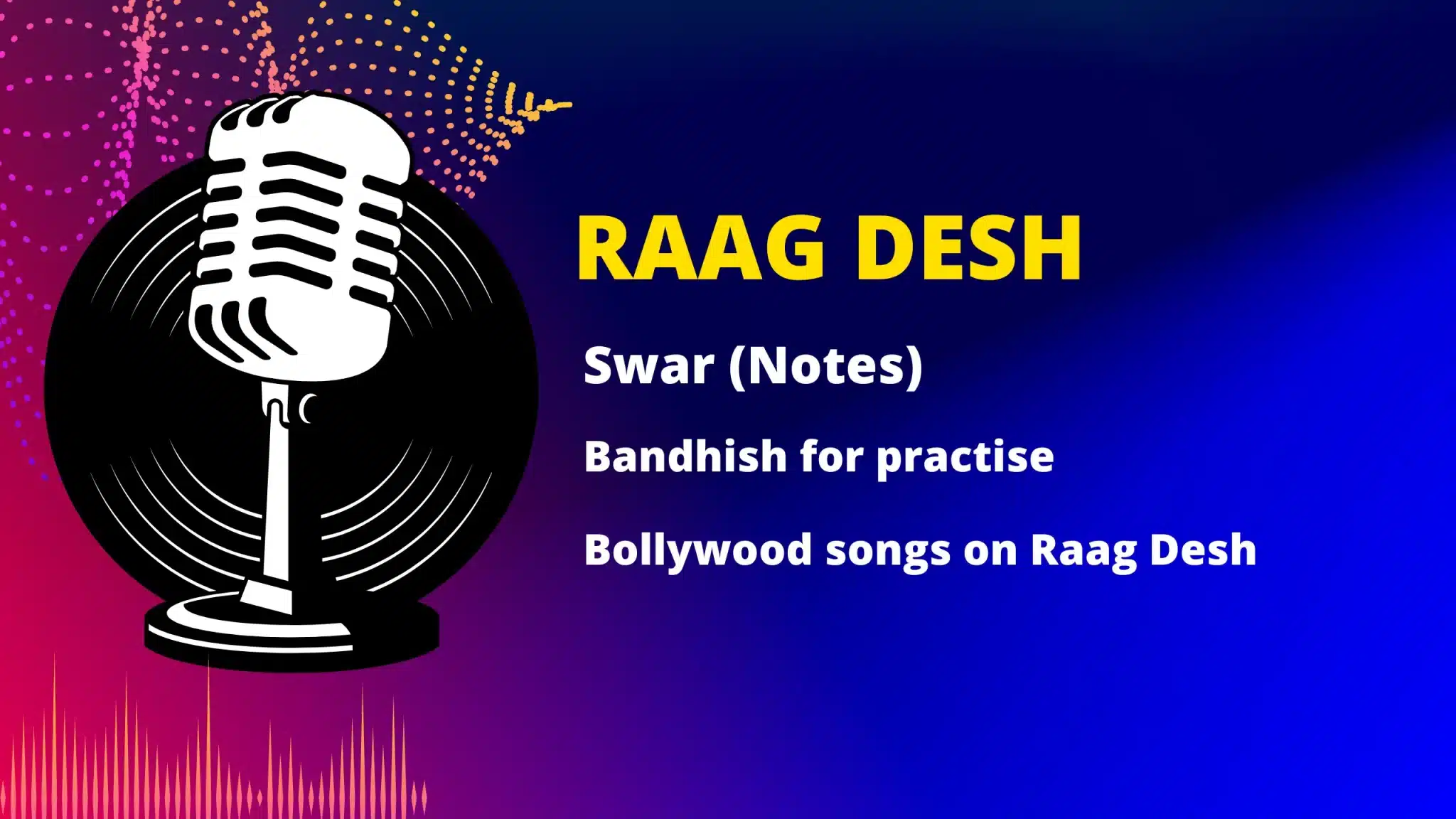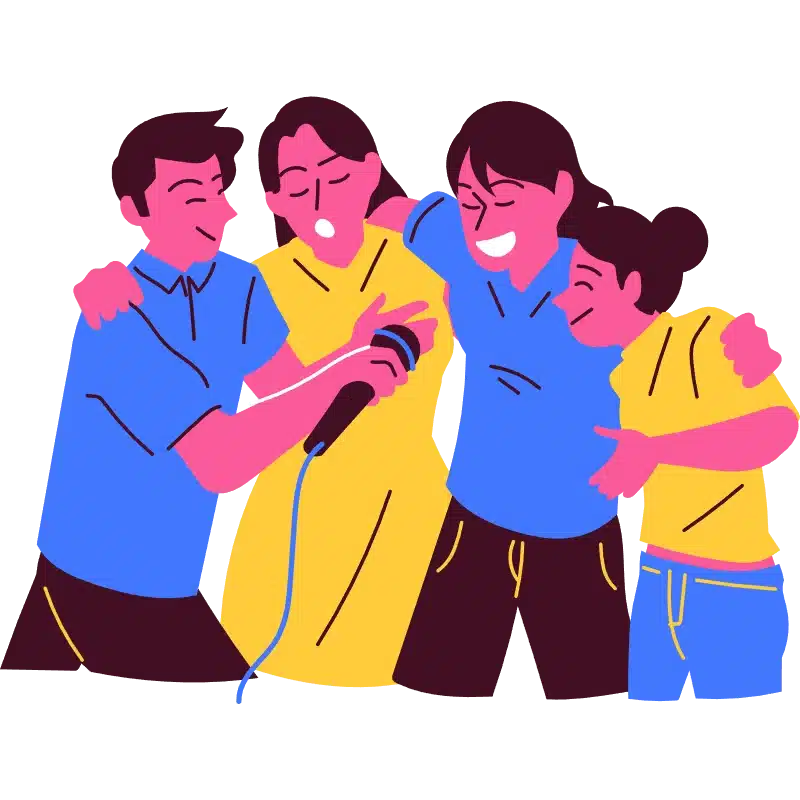Imagine this! In the hush of twilight, the wide sky wearing the hues of hope and longing, raag desh rises like a river of serenity, stirring memories and aspirations. Well, that’s how I feel everytime I listen to raag desh songs.
Rooted in the soil of Hindustani Classical traditions, raag desh parichay the fragrance of valour. It is not just a melody but emotions carved into sounds. Let’s into the musical structure of this raag, popular bandishs and other compositions for understanding the essence of raga desh.
Musical Characteristics of Raag Desh
Desh raag belongs to Khamaj Thaat and is sung during the late evening or night. Raag desh aaroh avroh are asymmetrical and vakra in nature. Its audav – sampurna in nature.
What is the Meaning of Vakra in Hindustani Classical Music?
‘Vakra’ literally means ‘crooked.’ A vakra raga does not follow a straight order in aaroh and avroh. This pattern of swaras enhances the raag’s expression and is considered as a creative tool in Hindustani Classical Music.
Raag Desh Aaroh Avroh
Aaroh: the ascending order of raag desh notes.
S R M P N S
Aaroh: the descending order of raag desh notes.
S N D P D M G R G, N S
Raag Desh Pakad
R MP, N D P, D M G R, G N S
Raag Desh Parichay
You’d notice, aaroh has five notes and the avroh has seven notes. Raag desh notes use shudh Nishad in the Aaroh, while Komal Nishad in Avroh. The rest of the swaras are shudh.
However, komal Gandhar is a Vivadi used to make the sound of raga desh performance more beautiful, usually in tar-saptak (higher octave). Madhyam is sometimes used as a kan-swar between Shadaj and Rishabh in aaroh.
The Meend from madhyam to rishabh via gandhar is one of the most vital features of this raga. The aaroh via shuddha nishad, and the transition from rishabh to komal nishad in the avroh form an important part of the melodies in this raga.
It is a very sweet melody that bears the Shadaj- Pancham (Sa-Pa) and Shadaj-Madhyam (Sa-Ma) Bhava and therefore very pleasing and essentially melodic. Rishabh is very prominent in this raga, quite a few times the singer rests on Re, making it a center to the melody.
Raag Desh thaat: Khamaj
Jati: Audava-Sampurna Vakra
Vadi / Samvaadi: Rishabh / Pancham
Samay: (9 PM – 12 PM) ; 2nd Prahar of the night ; Ratri ka Dwitiya Prahar
What Emotions are Expressed in Raga Desh?
Let me start with the gently flowing movements of the swaras that evoke yearning and tenderness in a natural setting like the monsoon. Raag desh, one of the Evening ragas in Hindustani music is used in many devotional compositions such as Bhajans for its humble, soulful characters. It is believed that these characters lend itself to a spiritual introspection.
Moreover, this iconic raag is known for its portrait of Veer rasa. Some of the most popular patriotic songs like Vande Mataram, ‘Ae Mere Watan Ke Logon’ are composed in using raag desh notes .“Desh” generates the raga of Shringar (beauty and illusion) in Uttaranga and Veer rasa (heroism and boldness) in Purbanga.
Compositions to Practise in Raag Desh
Rooted from Khamaj thaat, raag desh bandishs beautifully blends graceful phrases with different emotions. Every bandishs listed out here for you showcases the raag’s key features. Raag desh taans are also included for practice.
Bandish 1 : Rab Gun Gaye Re Tu
STHAYI
Rab Gun Gaya Re Tu Mana -2
Kaahe Bhatkat Fire Nisadina -2
ANTARA
Chin Bhangur Sab Jagat Pasara -2
Maya Jaal Birtha Kalapana
TAAN
STHAYI (8 Matras)
1. Sa Re Ma Pa Ni Ni Sa’ – , Sa’ Ni Dha Pa Ma Ga Re Sa.
2. Ni Sa Re Ma Pa Ni Dha Pa, Ni Dha Pa Ma Ga Re Ga Sa.
3. Pa Ni Sa’ Re’ Sa’ Ni Dha Pa , Ni Ni Dha Pa Ma Ga Re Sa.
ANTARA (16 Matras)
1. Sa’ Ni Sa’ Sa’ Pa Ni Sa’ Sa’ Ma Ma Pa Pa Ni Ni Sa’ Sa’ , Sa’ Ni Dha Pa Ni Dha Pa Ma Ma Ma Pa Pa Ni Ni Sa’ – .
2. Re’ Ga’ Re’ Sa’ Re’ Ni Sa’ Sa’ Sa’ Sa’ Re’ Re’ Sa’ Ni Dha Pa , Ma Pa Ni Ni Dha Pa Ma Pa Pa Dha Pa Ma Ga Re Ga Sa.
*Note*
1. This Bandish is sung in Teen Taal Madhya Laya and starts with Khali.
2. Ni and Ga in the taan section denote Komal Nishad and Komal Gandhar.
Bandish 2 : Beet Jaat Barkha Ritu
This Bandish is sung Ek Taal Madhya Laya.
STHAYI
Beet Jaat Barkha Ritu
Aaye Na Sajan Ae – – – ri
Ae – – – – ri , Ae – – – – ri -2
ANTARA
Un Bin Mohe Chain Na Aave -2
Kaam Kaaj Kachhu Na Bhaave -2
Nisadin Mohe Birah Sataye
Aaye na Sajan Ae – – – – ri
Bandish 3 : Mukut Chatak Girdhar Dhar
This Bandish is sung in the Taal Dadra (Madhya Laya).
STHAYI
Mukut Chatak Girdhar Dhar -2
Madhur Madhur He – – – -re -2
Matak Matak Chaal Chalat
Dagar Dagar He – – – – re
ANTARA
Mur Mur Murli Bajaye -2
Ee Sur Sur Sur Sunaye -2
Chal Bal Se Dhaay Dhaay
Gale Lagat Me – – – – re
Similar Ragas
| Features | Raag Desh | Raag Khamaj | Raag Tilak Kamod |
| Thaat (Parent Scale) | Khamaj Thaat | Khamaj Thaat | Khamaj Thaat |
| Aroha (Ascending) | S R M P N S’ | S G M P D N S’ | S R M P N S |
| Avroha (Descending) | S’ n P M P D n P M G R S | S’ N D P M G R S | S N D P M G R S |
| Vadi (Most Important Note) | Re (D) | Ga (G) | Re |
| Samvadi (Second Important) | Pa (G) | Ni (N) | Pa |
| Jati (Note Count) | Auduv-Sampurna | Sampurna- Sampurna | Auduv- Sampurna |
| Time of Performance | 2nd Prahar of the night | Late evening/night | 1st Prahar of the night |
| Nature | Solemn, patriotic | Romantic, playful | Light, devotional |
Charm of Raag Desh
Historical significance of raga desh is deeply tied with themes of freedom, cultural and popular music forms. The light classical nature of this raag made it a powerful vehicle for most of the raga desh famous songs. Beyond all these, raag desh songs connect to the Indian monsoon which historically symbolizes longing and abundance in literature.
Famous Songs & Rabindra Sangeet Based on Raag Desh
An apt rendition or recital of the raga desh swaras showcases the dazzling beauty of a blissful butterfly celebrating greenery all around. Patriotic compositions in raga desh including “Vande Mataram” (penned by Bankim Chandra Chatterjee), the national song of India. Tagore greets the advent of monsoon with one of his compositions “Esho Shyamal Sundoro” set on the monsoon raga while our National Poet Kazi Nazrul Islam’s “Desh” composition ” Piya Piya Piya Papiya Pukarey” makes us celebrate pathos.
Some of the raga desh popular recordings set on the raga, the great grandson of the legendary Ustad Inayat Hussain Khan Saheb (the founder of the ‘Rampur Sahaswan Gharana’), Ustad Rashid Khan recorded a beautiful Khyal on the bandish “Karam Kar Di Je Khwaja Muinuddin” that his grandfather created.
Pandit Shivkumar Sharma’s recital of “Desh” on his santoor is breathtaking while Pandit Pt. Hariprasad Chaurasia’s flute recital on the raga takes us to yesteryears. “Pukar” in the rendition of “Desh” often produces an exquisite emotive plea that best expresses the patriotic zeal! Ustad Mehdi Hassan’s thumri “ Umar Ghoomar Ghir Aayo re Sajni Badra“ Join our online Hindustani music classes and start your musical journeny with us.
FAQs
What is the mood of raag Desh?
Raag Desh’ mood is a blend of devotion, romance, patriotism and peace.
What is the time of raag Desh?
2nd Prahar of the night.
What is the ascent, descent and hold of raag Desh?
raag Desh aaroh avroh is S R M P N S' S N D P D M G R G, N S and the Pakad is R MP, N D P, D M G R, G N S.
Which Bollywood song is based on raag Desh?
Songs like Aji Raat Bhar, Gori Tore and Thandi Thandi are based on raag Desh.
Where can I watch raag Desh?
You can watch it on Youtube. raga Desh step-by-step tutorials are also available there.
Which raga is similar to Desh?
Raag Khamaj,Tilak Kamod are some of the similar raags.
Which thaat raga Desh belong to?
Raga Desh belongs to Khamaj Thaat.
Who are famous artists of raga Desh?
Pandit Bhimsen Joshi, Ustad Rashid Khan, Shuba Mugdal are some of the famous artists of raga Desh.
Related blog: Raag bhupali































